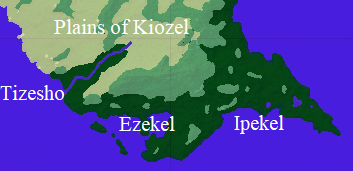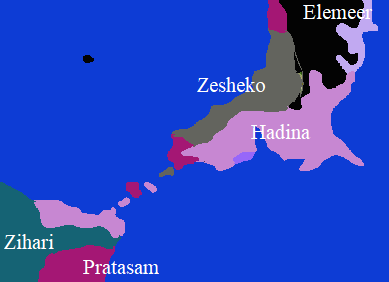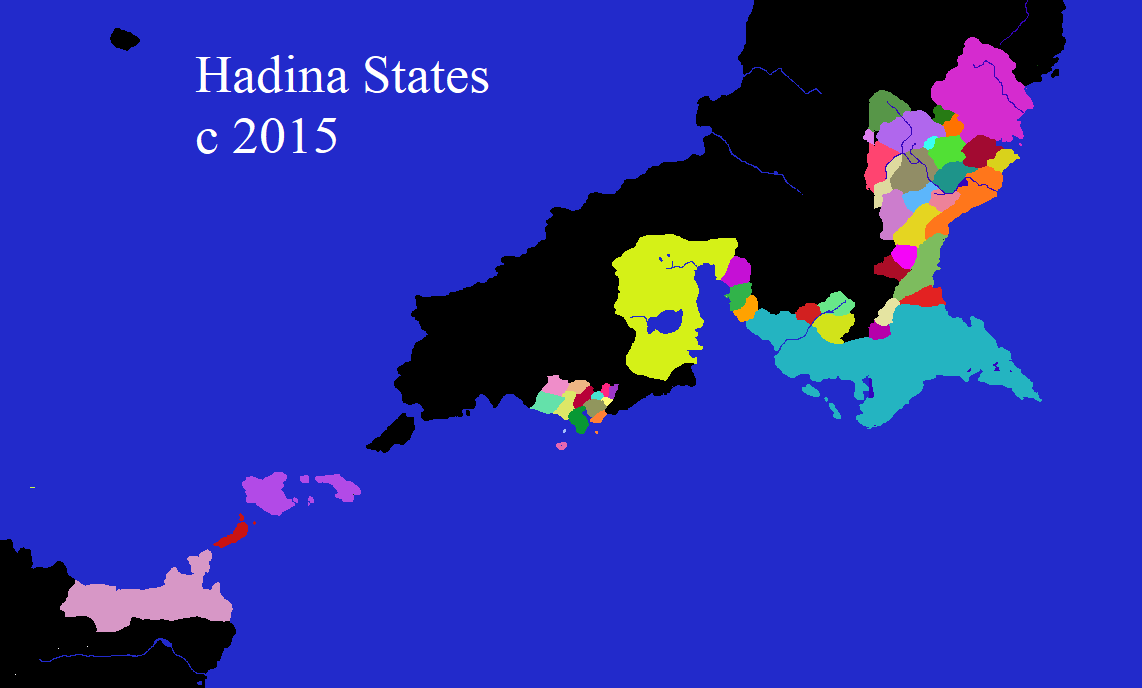Hadina
They say religion is the worship of the invisible. They say its composed of visions of Paradise, visions of soul. Hadina laughs at these words. For the soul is nothing but a reflection of the past, a memory that must be fed with remembrance. The dead are tethered to our world, for this material plane is the heart of all that exists. Afterlives, Gods, and cosmologies are capricious and flexible, if not illusory outright. What does matter, then? Deeds, objects, labor, the flesh and energy of our world. For labor is the sacred infusion of self and material, and the objects we create are our paths to immortality. We are born obligated to continue the work of our ancestors, renewing their spirits and linking our own to theirs in a great chain of existence. This great work will lead to the Hadi- The Final Revelation- the sacred state of existence that all life instinctually strives for: a future where work, virtue, and pleasure are all one, where the very ideas of sin or laziness or pain no longer exist.
Structure
| Rank | Selected By | Role | Number |
|---|---|---|---|
| Royal Priests | Recruited from hero cult | International Coordination | 6 |
| Hero/State Cultist | Recruited from community priests | Manages state functions and local holy sites | 36 major cults, 10 to 200 members each |
| Community Priest | Apprenticeship | Community holidays and government | Many |
| Family Priest | Apprenticeship | Burials and family shrines for big clans | Many |
Culture
Species-Cultural Preference: Sedentary
Morality Panic: Class and Ability
Object Veneration
History
Hadinan Context
Makes a Religion To Cope
Modern Hadina
Mythology & Lore
Hadina has no defined origin mythology, only a destiny for the world. Regardless of who the Gods may be, they are manifestations of the Divine Intent, the Izimvra. The Izimvra made the world for the same reason all people make things: because creation is both virtuous and because it is immortality. The Izimvra drives all beings of creation to create even more and to seek transcendent utopia. The bees and the ants, holy messengers, had their own prophets that taught them and imbued them with ultimate Izimvra before we even learned of it. Some even say it was a bee that landed on the prophet Elenon's shoulders and taught him the Final Revelation. For this reason, ants and bees must be treated respectfully as enlightened creatures.
What other Enlightened Beings or spirits exist? Many hold different accounts. The heavens are known only to the dead, and according to the deceased they are quite full of gods and monsters indeed! These include:
- Potaka the Weaver of Fate
- Zekravika the River Serpent
- Lonozi the Wind Rider
- Tunelo the Sky Queen
- Azerta, Goddess of War, Trade, Steel
- Alima the Masked Purifier
- Izikiro the Sunsmith
Cosmological Views
The heavens may be real, but they are inherently less real. No accomplishment in them matters or remains as a monument to their efforts. Over-worry about the nature of the afterlife is unnecessary, as true immortality is on the material plane.
The Lunar Pantheon are perceived as primeval ancestors, worthy of respect and veneration. Cults primarily focus on the "dutiful triad" of Orchid of Blue, Wimbo Aizitu, and Emesh. The dutiful triad may try to influence our world, but they understand that such influence is a give and take process and recognize their place within it. Lily of Red, Ishkibal, and Jade Atharzen are "forgetful spirits" that do not remember that they have died and seek to rule still as immortal monarchs. Hiku the Muse and Theia the Liberator are eccentric tricksters worthy of caution. Agamine the Lost is dead, their true name lost to time. And Haru is simply a lesser God that frequently visits the afterlife.
Tenets of Faith
- Preserve the World and Its Beauty: The world is a gift from our ancestors. Build and make prosperous, but do not risk what exists for your ephemeral dreams of success- prioritize preservation.
- Never Show Beastly Emotion: Animals, plants, stones- these things have no rights. We have a divine duty to differentiate ourselves from these base elements, through self control and purpose. Never show grief, anger, or spite in public, or you might put your very personhood at risk.
- Keep Alive the Memory of the Past: Memory is spirit. Remembrance feeds memory, and therefore spirit. It is your duty to remember the past, or the world you rely on will die and have to be rebuilt
- Honor Your Family and Community: We are born indebted to our family and community, and it is our life work to pay off that debt. Be respectful and dutiful.
- Respect the Dead and the Sacred: We live in a dead world, crafted by the still-moving hands of our ancestors. Disturb those dead, and expect retribution.
- Do Not Covet or Steal: Property is a sacred bond between person and material. To attack property is to attack the spirit. Envy is a path to grave sin and marks an inferior person.
- Let No Child Go Unclaimed: Blood is nothing- it is through the labor of raising a child that lineage is forged, both communal and parental. Blood preference is dishonesty, and unadopted children are a sign of laziness and foolishness.
Ethics
People have rights, objects do not. People act; objects are acted upon. Cruelty towards objects is still a sign of beastly behavior and emotional overreaction as well as disrespect towards the Gods and planet, but objects have no rights to their own fate. But what separates people from objects? Well a dryad can control itself; a tree cannot. A bat cannot have manners or make small talk, a Vesper can. Any object-like thing can earn its personhood through good behavior.
What is goodness, though? Well, it is the fulfillment of one's duties to another. We are born obligated to our families that raised us, our societies that enabled us, and our ancestors that made the world safe and prosperous. We fulfill those debts by creating joy and putting our effort to the betterment of others. Intent is important, but the attempt is the spirit of the thing- and the attempt is always framed in context. Not all situations have a good answer, but we do our best and that is what makes us good.
Worship
There are three forms of worship: reverence, memorial, and communion with the divine. These can overlap and often do. Reverence is prayers of thanks, memorial is feeding the past by remembering it, and communion is inviting in the divine intent and joining with it.
The most common form of this is work-prayer: communion and reverence with ancestors and Gods during day to day activities. By re-enacting and inviting in ancestors during work that they once did, one can rejoice with them and feel them working alongside you. By thanking and joining with the land-spirits as one harvests crops, one communes with them in an intimate and emotional way. Work, that sacred expression of self, is also an opportunity for all kinds of worship. Whenever a new method or technology is adopted, work begins immediately to find its divine purpose and inherently ritual.
Community festival is also important. Storytelling, community plays, and holidays of memorial are all ways for a community to acknowledge their debts to one another and join in divine harmony. It is also common to engage in divine-re-enactment: memorializing the spirits and the dead by giving them another chance to live through you. This is often done through donning a work of mask of them (ideally made by them). One can also invite and memorialize many deceased at once through powerful relic-masks that must be made and consecrated. Relic-masks are potentially dangerous as they invite shades of all the dead into themselves, and so are usually consecrated and restricted to a specific category: ghosts of a specific family are common in rural areas, while ghosts of a specific guild or trade are common in towns and cities. Urban Guild Masks are particularly useful in times of crisis to validate guild's morality and to unify the artisans or workers during wage negotiations.
Sects
Grave Knights: A specific order of Paladins, often of Emesh, found in the Kingdom of Alaran. They are believed to be channels for community spirits, and a way for poor youth to advance if gifted in combat. They are relic-guardians and avengers founded to protect the faithful against bandits and religious enemies and have become media icons of late.
Geomancers: Older than Hadina itself, the order of Geomancers has shrunk to a niche position in Ipekel but never truly faded. They adapted to the new religious order, becoming spiritual specialists that handle mystical healing and philosophy. This actually served them well, and they became quite proficient druids when they partnered with the Selkie Circle of the Sea in 1860.
"Memory is Spirit"
Founding Date
880
Type
Religious, Organised Religion
Demonym
Hadinan
Permeated Organizations
Remove these ads. Join the Worldbuilders Guild






Comments